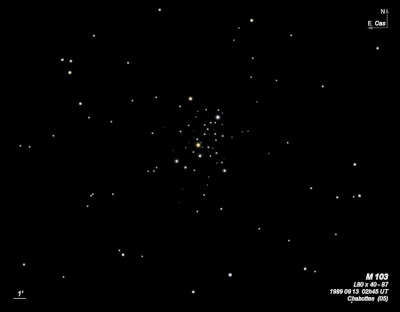
Pierre Méchain discovered M103 = NGC 581 = h126 in April 1781. Messier added it at the last minute to his 1781 catalogue (published in the 1784 Connaissance des temps), but since the discovery occurred after the manuscript was sent out for publication, he wasn't able to provide visual confirmation or specific coordinates.
William Herschel observed the cluster on 8 Aug 1783 and wrote, "14 or 16 pretty large stars with a great many eS ones. Two of the large ones are double, one of the 1st the other of the 2nd class. The compound eye glass shews a few more that may be taken into the cluster so as to make about 20. I exclude a good many straggling ones, otherwise there would be no knowing where to stop."
John Herschel included M103 in his Slough Catalogue (h126) but only referenced ∑131, Struve's entry (1825) from his catalogue of double stars, so he was apparently unaware of the equivalence with M103. He reported it on 29 Sep 1829 (sweep 213) as "A fine cl; R; rich; rather coarse; 6 or 8' diam; stars 10...11m. One of Struve's "acervi".
300/350mm - 13.1" (10/20/84): 50-60 stars in cluster, fairly rich. Includes several bright stars in a distinctive triangular wedge shape containing STF 131 at the NW edge (7.3/9.9/11.8 at 14" and 28" lined up to the SE) , colorful orange mag 8.4 SAO 11826 (M2-class supergiant) just SE of center, mag 8.9 SAO 11824 1' S of SAO 11826 and mag 8.2 HD 9365 on the SE edge [not a cluster member].
Notes by Steve Gottlieb